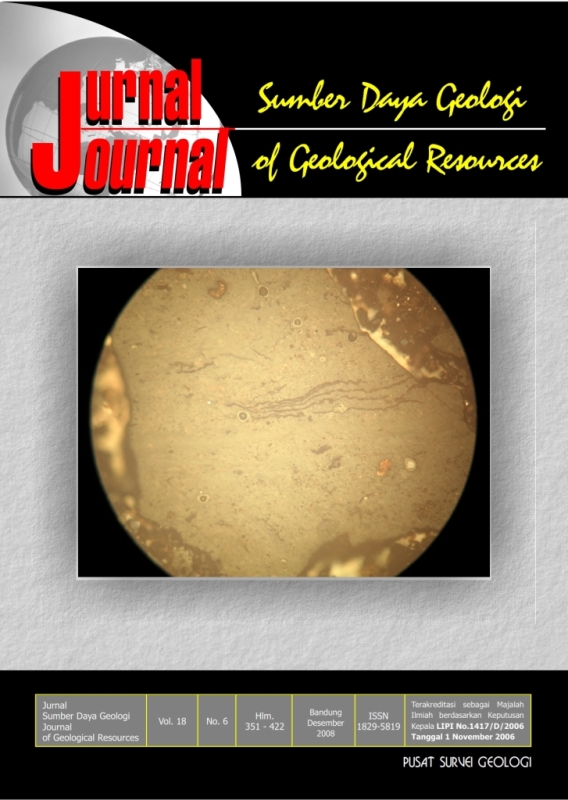COAL CHARACTERISTICS OF SAROLANGUN - PAUH REGION: Implication for Coalbed Methane potential
DOI:
https://doi.org/10.33332/jgsm.geologi.v18i6.255Abstract
The world energy crisis has effected the Indonesian energy supply, inspite of  Indonesia is rich in another potential geo- resources, such as Coalbed Methane (CBM), which can be used for solving this crisis. The geology and coal characteristics of the Muaraenim Formation in Sarolangun - Pauh region, suggest that the Coalbed methane resource in this area is prospective. Detailed organic geochemical and petrographical study, using fresh surface and subcrop samples of coal was conducted. Petrographically, the coal mainly consists of vitrinite group, and is essentially composed telovitrinite, telocolinite, and detrovitrinite, with rare to sparse inertinite, and minor exinite and mineral matter. A geochemical result indicates the range of volatile matter content is from 13.39% to 33.50%, total sulphur from 0.11 to 2.38%, ash between
0.68% and 52.4%, and moisture 18.01 up to 40.18% , with vitrinite reflectance values ranges from 0.35% to 0.47% . Furthermore the feature of micro-cleats or micro-cracks from SEM analysis are dominated by strike lines although some curved and sub-curved lines are also present. Open microcleats are predominant compared to close microcleats. Based on Barbara and Winter diagram, coalbed methane content derived from the Sarolangun- Pauh coal seam is expected to be low - moderate level, with methane content is present from 2.89 m3/t to 6.02 m3/t. SBC coalfield area shows that gas content is around 338.001, 354.6234 scf, Lubuk Napal is 743.232.370, 6576 scf, whilst the Sungai Dingin about 419.343,508.7245 scf.
Â
Keywords : coal characteristics,  Sarolangun-Pauh  Region, coalbed methane (CBM).
Downloads
References
Aminian, K., 2007. Evaluation of Coalbed Methane Reservoirs, Petroleum & Natural Gas Engineering Department, West Virginia University, 13p.
Bishop, M.G., 2001. The South Sumatera Basin Province: The Lahat/Talang Akar - Cenozoic Total Petroleum System. USGS. Open-file report 99-50-5.
Daly, M.C., Hooper, B.G.D., Smith, D.G., 1987. Tertiary Plate Tectonics and Basin Evolution in Indonesia
Proceedings, 6th Regional Congress on Geology, Mineral, and Hydrocarbon Resources of
Southeast Asia (GEOSEA VI), p.1-28.
Darman, H., and Sidi, F.H., 2000. An outline of the geology of Indonesia. Indonesian Association of Geologists, Jakarta, 254 pp.
de Coster, G.L., 1974. The Geology of the Central and South Sumatra Basin. Proceedings, IPA 3rd Annual Convention, p.77 - 110.
Gafoer, S. and Purbohadiwidjoyo, M.M., 1986. The Geology of Southern Sumatera and Its Bearing on the Occurrence of Mineral Deposits. Bulletin of Geological Research and Development Centre, No.12. Directorate General of Geology and Mineral Resources of Indonesia. Bandung, p. 15-30.
Kurnely, K., Tamtomo, B., Aprilian, S., And Doria, I., 2003. A Preliminary Study of Development of Coalbed Methane (CBM) in South Sumatra. SPE Asia Pacific Oil and Gas Conference and Exhibition held in Jakarta, Indonesia, 15-17 April 2003, 6p.
Panggabean, H. and Hermiyanto, M.H., 2006. Data Analisa Laboratorium “Scaning Electron Microscope†(SEM) terhadap 6 (enam) contoh Batuabara (CBM) dari Daerah Sarolangun, Jambi. Laboratorium Petrology dan Kimia, Pusat Survei Geologi, Bandung, Unpublished report.
Downloads
Published
Issue
Section
License
Authors who publish articles in Jurnal Geologi dan Sumberdaya Mineral (JGSM.Geologi) agree to the following terms:
- Authors retain copyright of the article and grant the journal right of first publication with the work simultaneously licensed under a CC-BY-NC or The Creative Commons Attribution–ShareAlike License.
- Authors are able to enter into separate, additional contractual arrangements for the non-exclusive distribution of the journal's published version of the work (e.g., post it to an institutional repository or publish it in a book), with an acknowledgment of its initial publication in this journal.
- Authors are permitted and encouraged to post their work online (e.g., in institutional repositories or on their website) prior to and during the submission process, as it can lead to productive exchanges, as well as earlier and greater citation of published work (See The Effect of Open Access)










